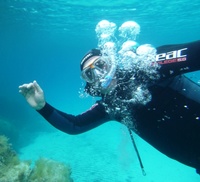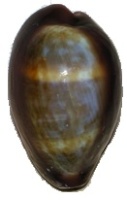Omogymna vullieti (Petuch & Myers, 2014)
+2
Whiteshark
Thierry VULLIET
6 participants
 Omogymna vullieti (Petuch & Myers, 2014)
Omogymna vullieti (Petuch & Myers, 2014)
Sam 17 Mai 2014 - 1:18
Voici une jolie Olive ... malheureusement l'unique exemplaire actuellement recensé....
Edouard Petuch m'a fait l'Honneur de la nommer en mon nom....

Description: Shell of average size for genus, rotund, inflated, bulbous, with rounded sides and profile and with widest part of body whorl just anterior of shoulder; spire proportionally very low, pyramidal, with rounded sides; spire whorls almost completely covered by thick calluses; shoulder distinctly rounded, grading into spire whorls; filament channel very narrow and shallow, edged by small carina; fasciole and fascicular band proportionally very small and poorly-developed, comprising only one-sixth of total shell length; oblique enamel line extremely posterior on body whorl, confined to shoulder area, extending from posteriormost edge of lip around to posteriormost end of columella; shell color pale yellow-white overlaid with dense network of interconnected reddish-tan triangles of various sizes; triangles on network pattern generally arranged with proportionally large triangles being interspersed within matrix of smaller triangles; edge of filament channel on shoulder marked with large, triangular reddish-brown flammules, arranged in separate clumps; columella colored pale cream-white, ornamented with 15 elongated, evenly-spaced tooth-like plications, which become larger toward anterior end; posterior section of columella smooth, without any teeth; aperture proportionally wide, slightly arcuate, becoming wider toward anterior end; interior of aperture pale cream-white; lip white, thickened and callused; protoconch exceptionally large, dome-shaped, composed of 2 broadly rounded whorls, pale cream-white in color.
Type Specimen: Holotype: length 27 mm, width 12 mm, LACM 3274.
Type Locality: Collected by commercial fishermen in a tangle net, brought up from 500 m depth off Balut Island, Sarangani Group, Batulaki Peninsula region, Mindanao Province, Philippines.
Range: At present, known only from deep water (500 m depth) in the northern Celebes Sea, off the southern coast of Mindanao Island, Philippines.
Etymology: Named for Thierry Vulliet of Arundel, Queensland, Australia, who recognized the species as new and who kindly donated the holotype for research.
Discussion: Until recently, the genus Omogymna was known to contain only four living species: O. paxillus (Reeve, 1850), the widest-ranging species, being found on shallow sand flats near coral reefs from East Africa all the way to French Polynesia; O. sandwichensis (Pease, 1860), which is endemic to shallow reef areas around the Hawaiian Islands; O. richerti (Kay, 1979), a deep water species (200 m depth) that ranges across eastern Polynesia, from Hawaii (the type locality) to the Marquesas and Tuamotu Islands; and O. leonardi (Petuch and Sargent, 1986), which ranges along southeastern Africa, from Mozambique south to the Natal coast (type locality off Durban). The discovery of the new deep water Philippines species brings the number of congeners up to five. Of these known Omogymna species, O. vullieti is closest only to O. richerti, from deep water areas of eastern Polynesia. Although having a similar color pattern of reddish-tan triangles on a cream background, the new species differs from the Hawaiian, Marquesan, and Tuamotuan O. richerti in being a stockier, less-elongated shell that is broader and wider across the shoulder, in having proportionally smaller and less-developed columellar plications, in having the oblique enamel line much farther back on the body whorl, very close to the filament channel, and, most importantly, in having a very low, truncated spire that is the exact opposite of the highly elevated and protracted spire seen on O. richerti.
ACKNOWLEDGMENTS
We would like to thank the following for their invaluable help in gathering data and specimens for the research used in this paper: Thierry Vulliet, Arundel, Queensland, Australia; Pierre Recourt, Egmond aan Zee, the Netherlands; Dennis Sargent, Mount Dora, Florida; Linda Zylman, Palm City, Florida; Lindsey Groves, Los Angeles County Museum of Natural History; and Thomas and Paula Honker, Delray Beach, Florida.
Edouard Petuch m'a fait l'Honneur de la nommer en mon nom....

Description: Shell of average size for genus, rotund, inflated, bulbous, with rounded sides and profile and with widest part of body whorl just anterior of shoulder; spire proportionally very low, pyramidal, with rounded sides; spire whorls almost completely covered by thick calluses; shoulder distinctly rounded, grading into spire whorls; filament channel very narrow and shallow, edged by small carina; fasciole and fascicular band proportionally very small and poorly-developed, comprising only one-sixth of total shell length; oblique enamel line extremely posterior on body whorl, confined to shoulder area, extending from posteriormost edge of lip around to posteriormost end of columella; shell color pale yellow-white overlaid with dense network of interconnected reddish-tan triangles of various sizes; triangles on network pattern generally arranged with proportionally large triangles being interspersed within matrix of smaller triangles; edge of filament channel on shoulder marked with large, triangular reddish-brown flammules, arranged in separate clumps; columella colored pale cream-white, ornamented with 15 elongated, evenly-spaced tooth-like plications, which become larger toward anterior end; posterior section of columella smooth, without any teeth; aperture proportionally wide, slightly arcuate, becoming wider toward anterior end; interior of aperture pale cream-white; lip white, thickened and callused; protoconch exceptionally large, dome-shaped, composed of 2 broadly rounded whorls, pale cream-white in color.
Type Specimen: Holotype: length 27 mm, width 12 mm, LACM 3274.
Type Locality: Collected by commercial fishermen in a tangle net, brought up from 500 m depth off Balut Island, Sarangani Group, Batulaki Peninsula region, Mindanao Province, Philippines.
Range: At present, known only from deep water (500 m depth) in the northern Celebes Sea, off the southern coast of Mindanao Island, Philippines.
Etymology: Named for Thierry Vulliet of Arundel, Queensland, Australia, who recognized the species as new and who kindly donated the holotype for research.
Discussion: Until recently, the genus Omogymna was known to contain only four living species: O. paxillus (Reeve, 1850), the widest-ranging species, being found on shallow sand flats near coral reefs from East Africa all the way to French Polynesia; O. sandwichensis (Pease, 1860), which is endemic to shallow reef areas around the Hawaiian Islands; O. richerti (Kay, 1979), a deep water species (200 m depth) that ranges across eastern Polynesia, from Hawaii (the type locality) to the Marquesas and Tuamotu Islands; and O. leonardi (Petuch and Sargent, 1986), which ranges along southeastern Africa, from Mozambique south to the Natal coast (type locality off Durban). The discovery of the new deep water Philippines species brings the number of congeners up to five. Of these known Omogymna species, O. vullieti is closest only to O. richerti, from deep water areas of eastern Polynesia. Although having a similar color pattern of reddish-tan triangles on a cream background, the new species differs from the Hawaiian, Marquesan, and Tuamotuan O. richerti in being a stockier, less-elongated shell that is broader and wider across the shoulder, in having proportionally smaller and less-developed columellar plications, in having the oblique enamel line much farther back on the body whorl, very close to the filament channel, and, most importantly, in having a very low, truncated spire that is the exact opposite of the highly elevated and protracted spire seen on O. richerti.
ACKNOWLEDGMENTS
We would like to thank the following for their invaluable help in gathering data and specimens for the research used in this paper: Thierry Vulliet, Arundel, Queensland, Australia; Pierre Recourt, Egmond aan Zee, the Netherlands; Dennis Sargent, Mount Dora, Florida; Linda Zylman, Palm City, Florida; Lindsey Groves, Los Angeles County Museum of Natural History; and Thomas and Paula Honker, Delray Beach, Florida.
_________________
The cure for anything is salt water - sweat, tears, or the sea.
~ Isak Dinesen
 Re: Omogymna vullieti (Petuch & Myers, 2014)
Re: Omogymna vullieti (Petuch & Myers, 2014)
Sam 17 Mai 2014 - 10:15
Felicitations Thierry et très intéressant ce spécimen même si j'ai des doutes quant à la profondeur… car à - 500 m il n'y a pas d'olives… seulement quelques amaldas/ancilla et encore ça commence à faire vraiment profond… Je pense que ce spécimen mort a roulé pour se retrouver si profond. A suivre !
 Re: Omogymna vullieti (Petuch & Myers, 2014)
Re: Omogymna vullieti (Petuch & Myers, 2014)
Sam 17 Mai 2014 - 10:27
Merci Vincent..
Et effectivement c'est une possibilité tout à fait possible.....
Et effectivement c'est une possibilité tout à fait possible.....
_________________
The cure for anything is salt water - sweat, tears, or the sea.
~ Isak Dinesen
 Clem4102Modérateur
Clem4102Modérateur
- Messages : 1935
Date d'inscription : 01/03/2011
Age : 47
Localisation : Corrèze
 Re: Omogymna vullieti (Petuch & Myers, 2014)
Re: Omogymna vullieti (Petuch & Myers, 2014)
Lun 26 Mai 2014 - 22:17
En voilà une de nouveautés 
C'est vrai que ton hypothèse Vincent est objective, c'est le pro qui parle.
Ce devrait être une vrai beauté si l'on pouvait en récolter des fraîches, affaire à suivre...
A++

C'est vrai que ton hypothèse Vincent est objective, c'est le pro qui parle.
Ce devrait être une vrai beauté si l'on pouvait en récolter des fraîches, affaire à suivre...
A++
 Goliath83Administrateur
Goliath83Administrateur
- Messages : 3588
Date d'inscription : 28/04/2012
Age : 65
Localisation : Paca
 Re: Omogymna vullieti (Petuch & Myers, 2014)
Re: Omogymna vullieti (Petuch & Myers, 2014)
Mer 28 Mai 2014 - 8:26


 TristanAccro
TristanAccro
- Messages : 324
Date d'inscription : 24/11/2010
Age : 52
Localisation : Nouméa
 Re: Omogymna vullieti (Petuch & Myers, 2014)
Re: Omogymna vullieti (Petuch & Myers, 2014)
Jeu 29 Mai 2014 - 9:21
Bonjour Thierry!
Et bien ! Avoir une olive à ton nom, c'est vraiment la classe ! Quel honneur. Félicitations ! On parlera encore de toi dans quelques centaines d'année , en espérant qu'il y aura toujours des olives sur Terre (ou plutôt dans les mers) !
Tristan
Et bien ! Avoir une olive à ton nom, c'est vraiment la classe ! Quel honneur. Félicitations ! On parlera encore de toi dans quelques centaines d'année , en espérant qu'il y aura toujours des olives sur Terre (ou plutôt dans les mers) !
Tristan
 Fabien du 25Assidu
Fabien du 25Assidu
- Messages : 706
Date d'inscription : 11/02/2012
Age : 44
Localisation : Pontarlier
 Re: Omogymna vullieti (Petuch & Myers, 2014)
Re: Omogymna vullieti (Petuch & Myers, 2014)
Jeu 29 Mai 2014 - 9:42
FELICITATIONS ! Tu rentres dans la panthéon de la malacologie ! La grande classe : 
Il ne te reste plus qu'à décrire une espèce et la boucle sera bouclée !!!

Il ne te reste plus qu'à décrire une espèce et la boucle sera bouclée !!!
Permission de ce forum:
Vous ne pouvez pas répondre aux sujets dans ce forum

